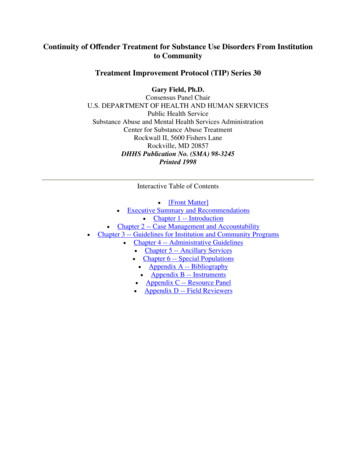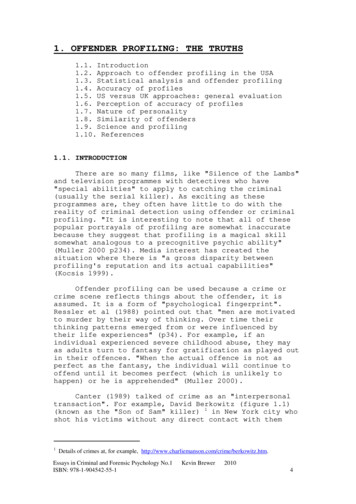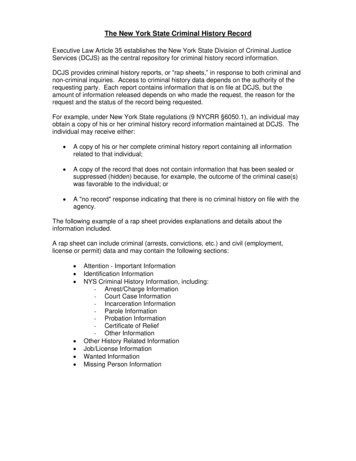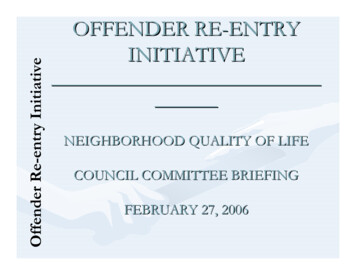
Transcription
Continuity of Offender Treatment for Substance Use Disorders From Institutionto CommunityTreatment Improvement Protocol (TIP) Series 30Gary Field, Ph.D.Consensus Panel ChairU.S. DEPARTMENT OF HEALTH AND HUMAN SERVICESPublic Health ServiceSubstance Abuse and Mental Health Services AdministrationCenter for Substance Abuse TreatmentRockwall II, 5600 Fishers LaneRockville, MD 20857DHHS Publication No. (SMA) 98-3245Printed 1998Interactive Table of Contents [Front Matter] Executive Summary and Recommendations Chapter 1 -- Introduction Chapter 2 -- Case Management and AccountabilityChapter 3 -- Guidelines for Institution and Community Programs Chapter 4 -- Administrative Guidelines Chapter 5 -- Ancillary Services Chapter 6 -- Special Populations Appendix A -- Bibliography Appendix B -- Instruments Appendix C -- Resource Panel Appendix D -- Field Reviewers
[Front Matter][Title Page]Continuity of Offender Treatment for Substance Use Disorders From Institution to CommunityTreatment Improvement Protocol (TIP) Series 30Gary Field, Ph.D.Consensus Panel ChairU.S. DEPARTMENT OF HEALTH AND HUMAN SERVICESPublic Health ServiceSubstance Abuse and Mental Health Services AdministrationCenter for Substance Abuse TreatmentRockwall II, 5600 Fishers LaneRockville, MD 20857DHHS Publication No. (SMA) 98‐3245Printed 1998[Disclaimer]This publication is part of the Substance Abuse Prevention and Treatment Block Grant technicalassistance program. All material appearing in this volume except that taken directly fromcopyrighted sources is in the public domain and may be reproduced or copied without permissionfrom the Substance Abuse and Mental Health Services Administration's (SAMHSA) Center forSubstance Abuse Treatment (CSAT) or the authors. Citation of the source is appreciated.This publication was written under contract number ADM 270-95-0013. Sandra Clunies, M.S.,I.C.A.D.C., served as the CSAT government project officer. Rose M. Urban, M.S.W., J.D.,C.S.A.C., served as the CDM project director. Other CDM TIPs personnel included Y-LangNguyen, production/copy editor; Raquel Ingraham, M.S., project manager; Virginia Vitzthum,former managing editor; and MaryLou Leonard, former project manager.The opinions expressed herein are the views of the Consensus Panel members and do not reflectthe official position of CSAT, SAMHSA, or the U.S. Department of Health and Human Services(DHHS). No official support or endorsement of CSAT, SAMHSA, or DHHS for these opinionsor for particular instruments or software that may be described in this document is intended orshould be inferred. The guidelines proffered in this document should not be considered assubstitutes for individualized patient care and treatment decisions.What Is a TIP?Treatment Improvement Protocols (TIPs) are best practice guidelines for the treatment ofsubstance use disorders, provided as a service of the Substance Abuse and Mental Health ServiceAdministration's Center for Substance Abuse Treatment (CSAT). CSAT's Office of Evaluation,Scientific Analysis and Synthesis draws on the experience and knowledge of clinical, research,
and administrative experts to produce the TIPs, which are distributed to a growing number offacilities and individuals across the country. The audience for the TIPs is expanding beyondpublic and private substance use disorder treatment facilities as substance use disorders areincreasingly recognized as a major problem.The TIPs Editorial Advisory Board, a distinguished group of substance use disorder experts andprofessionals in such related fields as primary care, mental health, and social services, workswith the State Alcohol and Drug Abuse Directors to generate topics for the TIPs based on thefield's current needs for information and guidance.After selecting a topic, CSAT invites staff from pertinent Federal agencies and nationalorganizations to a Resource Panel that recommends specific areas of focus as well as resourcesthat should be considered in developing the content of the TIP. Then recommendations arecommunicated to a Consensus Panel composed of non-Federal experts on the topic who havebeen nominated by their peers. This Panel participates in a series of discussions; the informationand recommendations on which they reach consensus form the foundation of the TIP. Themembers of each Consensus Panel represent substance use disorder treatment programs,hospitals, community health centers, counseling programs, criminal justice and child welfareagencies, and private practitioners. A Panel Chair (or Co-Chairs) ensures that the guidelinesmirror the results of the group's collaboration.A large and diverse group of experts closely reviews the draft document. Once the changesrecommended by these field reviewers have been incorporated, the TIP is prepared forpublication, in print and online. The TIPs can be accessed via the Internet on the NationalLibrary of Medicine's home page at the URL: http://text.nlm.nih.gov. The move to electronicmedia also means that the TIPs can be updated more easily so that they continue to provide thefield with state-of-the-art information.Although each TIP strives to include an evidence base for the practices it recommends, CSATrecognizes that the field of substance use disorder treatment is evolving, and research frequentlylags behind the innovations pioneered in the field. A major goal of each TIP is to convey "frontline" information quickly but responsibly. For this reason, recommendations proffered in the TIPare attributed to either Panelists' clinical experience or the literature. If there is research tosupport a particular approach, citations are provided.This TIP, Continuity of Offender Treatment for Substance Use Disorders from Institution toCommunity, spotlights the important moment in recovery when an offender who has receivedsubstance use disorder treatment while incarcerated is released into the community. The TIPprovides those who work in the criminal justice system and in community-based treatmentprograms with guidelines for ensuring continuity of care for the offender client.Treatment providers must collaborate with parole officers and others who supervise releasedoffenders. The TIP explains how these and other members of a transition team can share records,develop sanctions, and coordinate relapse prevention so that treatment gains made "inside" arenot lost.
Offenders generally have more severe and complex treatment needs than many substance usedisorder treatment clients, which makes case management an ideal approach. The TIP devotes achapter to ancillary services such as housing and employment. These needs must be addressed ifthe client is to remain sober. Finally, the TIP presents treatment guidelines specific topopulations such as offenders with mental illness, offenders with long-term medical conditions,and sex offenders. Appendixes include assessment instruments and a sample transition plan. ThisTIP represents another step by CSAT toward its goal of bringing national leadership to bear inthe effort to improve substance use disorder treatment in the United States.Other TIPs may be ordered by contacting SAMHSA's National Clearinghouse for Alcohol andDrug Information (NCADI), (800) 729-6686 or (301) 468-2600; TDD (for hearing impaired),(800) 487-4889.Editorial Advisory BoardKaren Allen, Ph.D., R.N., C.A.R.N.President of the National Nurses Society on AddictionsAssociate ProfessorDepartment of Psychiatry, Community Health, and Adult Primary CareUniversity of MarylandSchool of NursingBaltimore, MarylandRichard L. Brown, M.D., M.P.H.Associate ProfessorDepartment of Family MedicineUniversity of Wisconsin School of MedicineMadison, WisconsinDorynne Czechowicz, M.D.Associate DirectorMedical/Professional AffairsTreatment Research BranchDivision of Clinical and Services ResearchNational Institute on Drug Abuse
Rockville, Maryland
Executive Summary and RecommendationsIt is clearly in the public interest for offenders with substance use disorders to receiveappropriate treatment both in prison or jail and in the community after release. Numerous studiesshow that those who remain dependent on substances are much more likely to return to criminalactivity. Research also indicates that treatment gains may be lost if treatment is not continuedafter the offender is released from prison or jail. In part, this is because release presents offenderswith a difficult transition from the structured environment of the prison or jail. Many prisonersafter release have no place to live, no job, and no family or social supports. They often lack theknowledge and skills to access available resources for adjustment to life on the outside, allfactors that significantly increase the risk of relapse and recidivism.This TIP presents guidelines for ensuring continuity of care as offenders with substance usedisorders move from incarceration to the community. The guidelines are for treatment providersin prisons, jails, community corrections, and other institutions, as well as community providers.The following recommendations are based on a combination of research and the clinicalexperience of the Consensus Panel that developed this TIP. Recommendations based on researchare denoted with a (1); those based on experience are followed by a (2). Citations supporting theformer appear in Chapters 1 through 6. References to specific programs appear throughout thosechapters as well; Appendix B provides contact information for many of those model programs.Improving Transition to The CommunityMuch of the responsibility for offenders moving from incarceration to the community lies withcommunity supervision agencies, known in many jurisdictions as parole or postprisonsupervision. To reach the levels of system collaboration and services integration required, staffsfrom criminal and juvenile justice supervision and substance use disorder treatment agenciesmust reach beyond traditional roles and service boundaries by brokering services across systems,sharing information, and facilitating the treatment process. (2)Overcoming Obstacles to Successful TransitionsObstacles to successful transition include the fragmented criminal justice system, the lack ofattention to offender issues by community treatment providers, disjointed (or nonexistent)funding streams, and the varying lengths of sentences. The following will help overcome thoseobstacles: Fostering criminal and juvenile justice systems integration (for example, CSAT'sJuvenile/Criminal Justice Treatment Networks Program)Educating and providing incentives for community service providers to meet offender treatmentneedsIntegrating funding streams and expanding the funding poolCoordinating sentencing practices with treatment goalsFostering institution and community agency coordination that promotes continuity of treatment(2)
Case Management and AccountabilityCase ManagementCase management is the coordination of health and social services for a particular client. Whenprovided to offenders, case management also includes coordination of community supervision.Because case managers work across many agencies to serve their clients, they are sometimesknown as boundary spanners. See TIP 27, Comprehensive Case Management for SubstanceAbuse Treatment (CSAT, 1998b), for more on case management.Models for coordinating services for transitioning offenders include institution outreach,community reach-in, and third party coordination, in which a separate entity oversees transition.Though any one is appropriate for different circumstances, the Consensus Panel recommendscombined models for optimal transition planning. (2)Ideally, a single, full-time case manager works in conjunction with a transition team of involvedstaff members from both systems. However, if the infrastructure and resources do not allow for afull-time case manager position, the treatment provider working with the offender or thesupervision officer should take the lead in providing this function. (2)Need for AssessmentsTo assist in transition planning, the Panel recommends the use of standardized, comprehensiverisk and needs assessment tools appropriate to offender populations. These instruments should be"normed" for various populations, including women and racial and ethnic minorities. (1) Theinstruments should be in the language of the client.Assessments for offenders should be conducted within the institution as early and often aspossible, and also 3 to 6 months before the offender's release. (2)Multiple assessments of offenders having substance use disorders are necessary and shouldexamine Treatment needsTreatment readinessTreatment planningTreatment progressTreatment outcomeRisk and needs assessments are ideally conducted by a multidisciplinary team, with cooperationamong all players. Areas to be assessed include skills for daily living, stress management skills,general psychosocial skills, emotional readiness for the transition, literacy, and moneymanagement abilities. Criminal justice staff can contribute critical information on risk anddangerousness. Assessment results should follow the offender through the system(s). (2)Accountability
Violations of any aspect of the transition plan must be dealt with consistently, appropriately, andin a timely manner. (1) Innovative sanctions should be developed to address violations. Thesesanctions are best given in a graduated manner, with the most severe being a return to prison. (1)The methods used should be understood and agreed upon by both the criminal justice andsubstance use disorder treatment staffs.There should be periodic reviews of the issues addressed in the transition plan, including legalmatters, appropriate placement in a level of care, the effectiveness of sanctions, and the extent towhich the offender is meeting expectations. Correctional and treatment personnel shoulddecrease levels of supervision as the offender takes on more responsibility.An individualized relapse prevention plan should be developed for each offender. It is oftendeveloped as a standard form, written in simple, nonclinical language, with a checklist ofbehavioral indicators that help predict the potential for relapse. The plan should be used by allparties: the offender, treatment agency, supervising officer, and others. (2)Treatment needs should be reassessed when there are problems (e.g., "dirty" urines, lack ofprogress in treatment) and, if clinically appropriate, the offender should be moved to a higher ormore intensive level of care. (1) The length of stay in the program should be determined by thetreatment provider who, along with the community supervision officer, can monitor the progressof the offender.Guidelines for Institution and Community ProgramsInstitutionsThe term institution refers to prisons, jails, and youth detention facilities. Prisons are eitherFederal or State facilities that usually house offenders for 1 year or more. Prisons represent theend of the adjudication process, whereas jails contain offenders who have not come to trial aswell as those with short sentences. Jails are usually run by local governments, though someStates, such as Alaska, oversee a jail system. Youth detention facilities provide temporary careand restrictive custody for juvenile offenders (or juveniles alleged to be delinquent). Youthdetention can take place pre- or postadjudication, and facilities are usually under localjurisdiction. Regardless of which level of government is responsible for the facility, institutionprograms should comply with State treatment standards to the extent possible, bringing thoseprograms into a larger context of community-based treatment. To that end, institutional treatmentshould focus on preparing and motivating the offender for continued care in the community. (1)
Chapter 1 IntroductionOn any given day, some 1.7 million men and women are incarcerated in Federal and Stateprisons and local jails in the United States, and a recent study suggests that more than 80 percentof them are involved in substance use. In 1996 alone, taxpayers spent over 30 billion toincarcerate these individuals -- who are the parents of 2.4 million children. Put another way, oneof every 144 American adults is behind bars for a crime in which substances are involved (TheNational Center on Addiction and Substance Abuse at Columbia University [CASA], 1998).By a variety of measures, it is clear that substance use disorders disproportionately affectincarcerated Americans (Reuter, 1992; CASA, 1998; Federal Bureau of Prisons, 1997). Yet thispopulation is significantly undertreated: Although prison substance use disorder programsannually treat more than 51,000 inmates, this figure represents less than 13 percent of theoffender population identified as needing treatment. Studies also indicate that (with the exceptionof detoxification) most offenders have never received treatment in the community (Lipton et al.,1989; Peyton, 1994). Clearly, the majority of individuals in the criminal justice system in need ofsubstance use disorder treatment are not receiving services -- either while they are incarceratedor after release to the community.Providing substance use disorder treatment to offenders is good public policy. Recent researchshows that punishment is unlikely to change criminal behavior, but substance use disordertreatment that also addresses criminal behavior can reduce recidivism (Andrews, 1994). Inmateswith substance use disorders are the most likely to be re-incarcerated -- again and again -- andthe length of their sentences continually increases. The more prior convictions an individual has,the more likely he has a substance use disorder. In State prisons, 41 percent of first offendershave used drugs, compared to 63 percent of inmates with two prior convictions and 81 percent ofinmates with five or more prior convictions. Half of State parole and probation violators wereunder the influence of drugs, alcohol, or both when they committed their new offense. Stateprison inmates with five or more prior convictions are three times more likely than first-timeoffenders to be regular crack cocaine users (CASA, 1998). Offenders with substance usedisorders not only crowd the nation's prisons, they are also responsible for a disproportionateamount of crime and for relatively violent crime. Compared to offenders who do not use drugs,drug-using "violent predators" commit many more robberies, burglaries, and other thefts(Chaiken, 1986).However, offenders who have completed substance use disorder treatment during incarcerationare still at great risk for relapse and recidivism when released. They need a variety of services tomaintain sobriety during their transition from the institution to the community. This chapterprovides an overview of the benefits of those transitional services. It also discusses obstacles toimplementing such services and provides strategies for overcoming these obstacles. Finally,models for transitional services are described.Benefits of Offender TreatmentTreatment During Incarceration
Some incarcerated offenders enter treatment for the same reasons as those "on the outside": Theywant to stop using substances and need help. Others, however, may have different motivations:boredom, the desire to improve their chances for parole, a wish to escape the violent culture ofgeneral population, or some combination of the above. Others may be mandated to treatment bythe courts. Surprisingly, research shows that once an offender begins treatment, outcomes are notaffected by the reasons for entering treatment (Leukefeld and Tims, 1988). A certain proportionof those who undergo treatment within the institution will succeed if supervised closely (Anglinand McGlothlin, 1984; Petersilia et al., 1992). Other key findings on the effectiveness ofsubstance use disorder treatment within correctional institutions include the following: Prerelease therapeutic communities have shown high rates of success among inmates studied(Wexler et al., 1988; Field, 1989).Involvement in substance use disorder treatment is associated with decreased criminalrecidivism. Improvements have been seen in rates of rearrest, conviction, reincarceration, andtime to recidivate (Field, 1995a; Inciardi, 1996; Peters et al., 1993; Swartz et al., 1996; Wexler etal., 1990).Involvement in substance use disorder treatment is associated with decreased substance useand relapse and other health‐related outcomes (Inciardi, 1996; Martin et al., 1995; Wexler et al.,1990).Duration of correctional substance use disorder treatment is associated with positive treatmentoutcomes. Research has shown that, up to a point, longer lengths of treatment are moreeffective than shorter lengths of treatment for substance‐using offenders (Swartz et al., 1996;Wexler et al., 1992).Involvement in substance use disorder treatment, such as prison‐based therapeuticcommunities, is associated with successful parole outcomes (including reductions in parolerevocations) (Field, 1989; Wexler et al., 1992).Inmates involved in substance use disorder treatment had reduced rates of re‐arrest and relapsewhen compared with inmates who did not participate (Federal Bureau of Prisons, 1998).Treatment During Transition To the CommunityService systems should provide offenders with appropriate treatment, since no treatment is likelyto lead to continued drug use and crime. Treatment that stops when the offender is released,however, may not be enough. Release presents offenders with a difficult transition from thestructured environment of the prison or jail: Despite the hardships endured "inside," they at leastknew what to expect. Many offenders are released with no place to live, no job, and withoutfamily or social supports. They often lack the knowledge and skills to access available resourcesfor adjustment to life on the outside, all factors that significantly increase the risk of relapse andrecidivism (Leshner, 1997). The positive effects of substance use disorder treatment withincorrectional institutions may diminish once the offender moves out of the institutionalenvironment unless followup care is provided in the community (Martin et al., 1995; Peters etal., 1992; Swartz et al., 1996).The benefits of treatment during the transition from incarceration to the community aresubstantiated in several recent studies. In a study of drug offenders in Delaware, offenders whoparticipated in 12 to 15 months of treatment in prison and another 6 months of treatment in thecommunity were more than twice as likely to be drug-free 18 months after release as those who
had only the prison treatment. Those offenders were also arrested much less in the year and ahalf following release (Inciardi, 1996). A similar study in California had comparable results(Wexler, 1996). Continuity of care from the institution to the community is associated withpositive outcomes for prevention of relapse and criminal recidivism in other research as well(Swartz et al., 1996; Wexler et al., 1990).
Chapter 2 Case Management and AccountabilityCoordinating systems to help the newly released offender can seem overwhelming, due in largepart to the burgeoning caseloads carried by public sector agencies. Not only are the criminaljustice and substance use disorder treatment systems fragmented and sprawling, but the offenderwill likely need ancillary services as well (discussed in Chapter 5), which calls for casemanagement. As discussed in Chapter 1, case management can follow an outreach, reach-in, orthird-party approach, or some combination of the three. No matter what the model, researchshows cost benefits, through reduced recidivism, of cross-system integration for offendertransitional services (Inciardi, 1996; Abt Associates, 1995; Swartz et al., 1996).Case management is the function that links the offender with appropriate resources, tracksprogress, reports information to supervisors, and monitors conditions imposed by the supervisingagency. These activities take place within the context of an ongoing relationship with the client.The goal of case management is continuity of treatment, which, for the offender in transition, canbe defined as the ongoing assessment and identification of needs and the provision of treatmentwithout gaps in services or supervision. Accountability is an important element of a transitionplan, and case management includes coordinating the use of sanctions among the criminaljustice, substance use disorder treatment, and possibly other systems.Case Management in Transition PlanningIdeally, case management activities should begin in the institution before release and continuewithout interruption throughout the transition period and into the community. It is recommendedthat transition planning begin at least 90 days before release from jail or prison. Early initiationof transition planning is important because it establishes a long-term, consistent treatmentprocess from institution to community that increases the likelihood of positive outcomes. Thecase manager's communication with other transition team members at an early stage supports allaspects of the offender's recovery and rehabilitation (e.g., education, health, vocational training).Ideal Array of ServicesCertain services are integral to a substance-using offender's successful transition to thecommunity. Reassessments should be conducted at various stages throughout the incarcerationand community release process. Similarly, offenders also need continued supervision afterinstitution release. Continued supervision also includes ongoing monitoring and assessment ofthe offender's needs. These periodic substance use disorder and supervision assessments shouldform the basis for ongoing case management and service delivery. However, additionalassistance is needed in a number of areas prior to and after release to prepare the offender for thereturn to family, employment, and the community.Often the offender needs help finding housing, since family and social support networks andfinancial resources may be minimal. Other activities may include teaching basic life skills suchas budgeting, using public transportation, seeking and maintaining employment, and parenting.Many offenders have a history of job instability, unemployment, or underemployment.Improving the clients' likelihood of obtaining a job through general equivalency diploma (GED)
preparation, enrollment in an educational program, vocational training, or job-seeking skills classincreases their chances of success after release.Many offenders need training to enhance interpersonal skills in both family relationships andwith peers. Training in anger management and in parenting groups can provide new methods forresolving conflicts and facilitating reintegration into the family and community. If possible, thefamily should be involved in case management and treatment services during the transition to thecommunity. Participation in self-help groups is an important adjunct to substance use disordertreatment to engage the offender in the larger peer support community.The array of services identified reflects the multiple psychosocial needs of offenders, and takesinto account the likelihood that offenders will have periods of backsliding requiring moreintensive levels of treatment and supervision.An effective transition plan is dynamic and evolves as the offender accepts greater responsibility.The offender should be present at team meetings so that she can see accountability modeled asshe participates with team members in implementing the plan in the community. Being a part ofthe planning process helps offenders begin to make their own decisions and take responsibilityfor themselves. Because of the clear system of sanctions and rewards, a sense of accountability isreinforced.The Role of the Case ManagerContinuity of care implies that the range of services needed by offenders are received, regardlessof the system. When the correctional system and the treatment system collaborate effectively,there is an increased likelihood of treatment success and a reduction in the risk of relapse andfuture criminal behavior.Case management is a critical element underlying continuity of care. Studies indicate that casemanagement improves shorter term outcomes of treatment for substance use disorders (Shwartzet al., 1997). The case manager(s) links the offender with necessary resources, tracks progress,reports information to supervisors, and monitors conditions imposed by the court. Systems differwidely in terms of which entity provides case management services, but the necessary functionsare the same, whether this role is filled by one person, an interagency team, or a separate agency.The case manager works directly with the client and collaborates with other criminal justice andtreatment provider representatives to ensure that the offender maintains abstinence and avoidsreoffending.Case management functions typically include the following activities: Assessing an offender's needs and ability to remain substance‐ and crime‐freePlanning for treatment services and other criminal justice obligationsMaintaining contact with the probation officer and other criminal justice officialsBrokering treatment and other services for the offenderMonitoring and reporting progress to other transition team members
Providing client support and helping the offender with all involved systems (i.e., treatment,criminal justice, and child welfare)Monitoring urinalysis, breath analysis, or other chemical testing for substance useProtecting the confidentiality of clients and treatment records consistent with Federal and Stateregulations regarding right to privacy (42 Code of Federal Regulations [C.F.R.], Part 2)Staff members of the program Treatment Alternatives for Safe Communities (TASC) begin casemanagement services for the offender as early as local jurisdictions permit -- pretrial,presentence, postadjudication, or prerele
provided to offenders, case management also includes coordination of community supervision. Because case managers work across many agencies to serve their clients, they are sometimes known as boundary spanners. See TIP 27, Comprehensive Case Management for Substance Abuse Treatment (CSAT, 1998b), for more on case management.











